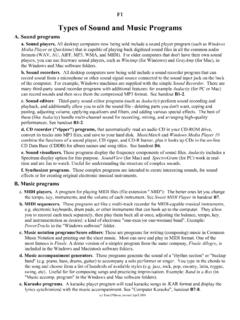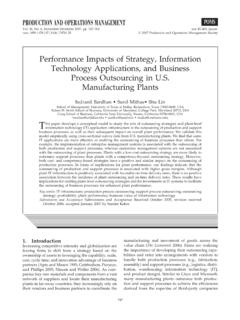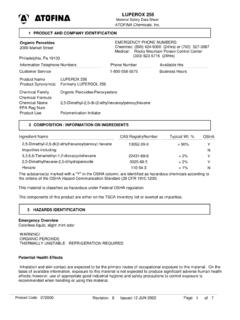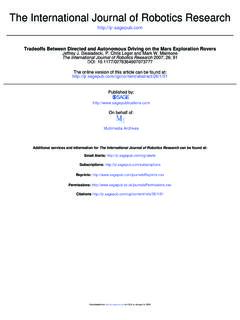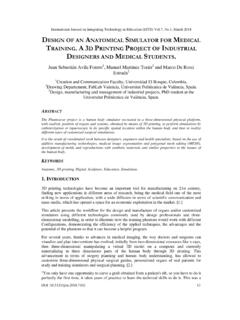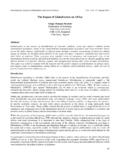Transcription of Raquel De María, Ismael Díaz*, Manuel Rodríguez, and ...
1 Raquel De Mar a, Ismael D az*, Manuel Rodr guez, and Adri n S izIndustrial methanol from syngas : Kinetic Studyand Process SimulationAbstract:In this study, a detailed rigorous kinetic modelis proposed for the industrial production of methanoltaking into account changes in total mole flowrate. Thekinetic model proposed is compared with the one pro-posed in literature (Rezaie et al., Chem Eng ProcessProcess Intensification 2005;44:911 21), showing signifi-cant differences in terms of compositions and total moleflow. A complete simulation of the methanol productionprocess is developed with a commercial software. Therigorous reactor model is integrated in the simulationusing the CAPE OPEN standard.
2 Flowsheet simulation iscarried out, and results show small differences with thosefound in previous studies (Luyben, Ind Eng Chem Res2010;49:6150 63).Keywords: methanol , reactor model, process simulation*Corresponding author: Ismael D az,Chemical TechnologyLaboratory, School of industrial Engineering, Technical University ofMadrid, C/Jos Guti rrez Abascal 2, 28006, Madrid, Spain, De Mar a:E-mail: guez:E-mail: n S Chemical Technology Laboratory,School of industrial Engineering, Technical University of Madrid,C/Jos Guti rrez Abascal 2, 28006, Madrid, Spain1 IntroductionNowadays, methanol is one of the most consumed com-modities around the world with an expected globaldemand of million metric tons [1].
3 Its main applica-tions are as fuel, additive or reactant in the fine chemicalindustry, but others are emerging such as hydrogen car-rier for fuel cell technology applications or denitrificationagent for wastewater treatment. So its importance in thechemical industry is clearly , methanol was produced by wood distillationwhich was proved a very inefficient method [2]. The firstindustrial methanol production process needed a high-pressure (around 300 atm) syngas reaction, and it waspatented by BASF in 1923. Catalysts used in these earlyprocesses were based on ZnO/Cr2O3. The ICIs companygot some good results using copper dispersed on zinc-based catalysts (1960s). This development allowed theuse of milder conditions, strongly decreasing both costsand process risks.
4 This is still the base of the catalystsemployed from syngas synthesis involves hydrogena-tion of CO (1) and CO2(2) and reversed water gas shiftreactions (3):CO 2H2$CH3OH H298 90:55kJ=mol 1 CO2 3H2$CH3OH H2O H298 49:43kJ=mol 2 CO2 H2$CO H2O H298 41:12kJ=mol 3 As shown in the heats of reaction, the global processis exothermic, reaching highest conversions at lowtemperatures. This fact, coupled with the high capacityof the process, makes the reactor design to be the stickingpoint in the process. Therefore, companies have investedgreat efforts in the development of their own of the designed industrial reactors are packed bedreactors ( ICI, Kellogg and Linde processes) where thecatalyst is fixed inside the tubes and cooling is providedthrough a reactor jacket.
5 Another design is the three-phase reactor carried out by Chem Systems, where thecatalyst is fluidized in an inert liquid and the gas phaseis composed of reactants and products except methanolwhich is absorbed by the liquid phase. Thisdesign improves heat transfer and catalyst deactivationaspects [3].The aim of this study is to investigate the influence ofdifferent kinetic approaches on the results of a validatedprocess simulation model. The remainder of this article isorganized as follows: Section 2 presents two kinetic mod-els (one from literature and one provided by the authors),Section 3 describes the process simulations where theprevious developed reactor model is integrated alongwith the whole model performance, and finally, Section4 draws some journal of Chemical Reactor Engineering 2013; 11(1): 469 477 Brought to you by | University of Maryland - College ParkAuthenticatedDownload Date | 2/13/15 9:41 PM2 Kinetic Literature modelsThe key aspect in the simulation of the methanolprocess is the reactor behaviour.
6 Many efforts havebeen done for the correct modelling of the kinetic pro-cesses involved. Mainly, two kinds of models are pro-posed depending if the solid is taken or not into accountfor the model. If only mole and energy balances areapplied to the fluid phase, then the model is calledhomogeneous. If both solid- and gas-phase molar andenergy balances are carried out, then we have ahetero-geneousmodel. The expressions here adopted for thetwo models are adapted from the work of Rezaie et al.[4] and Yusup et al. [5]. Heterogeneous modelThe model considers mass and energy transfersbetween solid and fluid phases as well as energyexchange between reactor fluid phase and the coolantin reactor jacket.
7 Pressure drop was computed by Ergun sequation [6].Some other assumptions were taken: Time independence (stationary condition). Neither axial nor radial dispersion. Coolant temperature keeps constant. Effectiveness factor ( ) value equal to 1. This is aconservative assumption because it has beenreported values higher than 1 for this factor, as inRef. 7. Intraparticular diffusion and catalyst deactivationhas not been taken into account. Ideal gas phase. Constant molar flux along the assumption will be discussed later on Section the author s model is proposed. Basic equations ofthis model are:(a) Solid-phase mole balance BCtdyisdt 0 kgiyi ys ri Bai 1;2;..;N 4 (b) Solid-phase energy balance BCpsdyisdt 0 avhfT Ts BaXNi 1 ri Hfi 5 (c) Gas-phase mole balance BCtdyidt 0 FtAcdyidz avCtkgiyi ys i 1;2.
8 ;N 6 d) Gas-phase energy balance BCtCpgdTdt 0 FtAcCpgdTdz avhfT Ts DiAcUshellTshell T 7 e) Ergun s equationdPdz L 10 61:75 1501 BRe 1 B 3Bu2g gDp 8 The resolution can be carried out, because it is a so-calledinitial value problem with known boundary conditions atthe entrance of the reactor:z 0!yi yi0z 0!T T0 9 Homogeneous modelThis model is essentially the same than before with theparticularity that there is neither a temperature nor aconcentration gradient between the solid and fluidphase. This means thatyi yisandT Mass homogeneous model(author s model)Previous models were adopted from literature [4, 5],and it was observed an imperfection in their of them supposed that total molar flux (Ft) remainsconstant along the reactor.
9 As it can be observed fromreactions involved, all the compounds are gases atreaction temperature and pressure. Besides, it can beseen that there are net changes in the mole number ofchemical substances. So, under these conditions, theassumption of constantFtis not valid. To overcome it, anew model based on mass fractions and fluxes is pro-posed. In the new model, total mass flow (Wt) De Mar a et al.: industrial methanol from SyngasBrought to you by | University of Maryland - College ParkAuthenticatedDownload Date | 2/13/15 9:41 PMThe model is derived from the homogeneous modelof Section , whereFiimole flow wimass fractioni Mimolecular weighti Wttotal mass flow 10 Model balances are expressed at follows:(a) Gas-phase mass balance0 WtAcdwidz Mi Bai 1;2.
10 ;N 11 (b) Gas-phase energy balance0 WtAcCpgdTdz DiAcUshellTshell T BaXNi 1 ri Hfi 12 (c) Ergun s equationdPdz L 10 61:75 1501 BRe 1 B 3Bu2g gDp 13 KineticsIn this model, kinetic expressions were taken from thework of Graaf et al. [8]. Heat of formation correlations forthe species were calculated from bibliographic correla-tions [9, 10] in order to predict the change of the heat ofreaction with temperature. Values of both kinetics andequilibrium temperature-dependent parameters weretaken from Graaf et al. [8]. Eqs [14 16] show the kineticexpressions for the three existing k1 KCOpCOp3=2H2 pCH3OH=p1=2H2Kp1 hi1 KCOpCO KCO2pCO2 p1=2H2 KH2O=K1=2H2 pH2 Ohi 14 r2 k2 KCOpCOp3=2H2 pCH3 OHpH2O=p1=2H2Kp2 hi1 KCOpCO KCO2pCO2 p1=2H2 KH2O=K1=2H2 pH2 Ohi 15 r3 k3 KCOpCOpH2 pCH3 OHpH2O=p3=2H2Kp2 hi1 KCOpCO KCO2pCO2 p1=2H2 KH2O=K1=2H2 pH2 Ohi 16 Mass-transfer correlationsValues of mass-transfer coefficient (kgi) were computed inthe reactor using the Cussler correlation [11].
